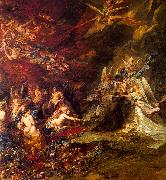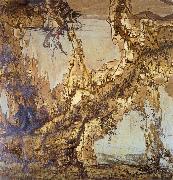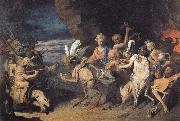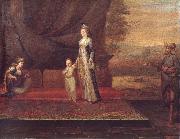Wholesale Oil Painting No Minimum |
|||||||||||
|
|
|||||||||||

|
|||||||||||
|
|
|
||||||||
|
|
||||||||
The Temptation of St.Anthony
The Temptation of St.Anthony Painting ID:: 2040 |
1869
Musee d'Orsay, Paris 1869 Musee d'Orsay, Paris |
|||||||
|
|
||||||||
David TeniersBelgian 1610-1690 David Teniers Gallery Flemish painter. His father, also named David Teniers (1582 ?C 1649), was a painter of primarily religious subjects. The younger Teniers was highly prolific and is best known for his genre scenes of peasant life, many of which were used for tapestry designs in the 18th century. He was brilliant at handling crowd scenes in an open landscape and adept at characterizing his figures with a warm, human, and often humorous touch. As court painter to the archduke Leopold William, he also made many small-scale copies of paintings in the archduke collection; engraved and published as Theatrum Pictorium (1660), they constitute a valuable source as a pictorial inventory of a great 17th-century collection. |
||||||||
|
|
||||||||
|
|
The Temptation of St.Anthony
The Temptation of St.Anthony Painting ID:: 29198 |
mk65
Oil on canvas
39x52"
mk65 Oil on canvas 39x52" |
||||||
|
|
||||||||
Napoletano, FilippoItalian, approx. 1587-1629 Italian painter and engraver. From 1600 until at least 1613 he was in Naples, where the naturalism of landscape painters from northern Europe, particularly Paul Bril, Goffredo Wals ( fl 1615-31) and Adam Elsheimer, influenced his early development. After 1614 he was in Rome and became acquainted with the landscapes and seascapes of Agostino Tassi. In 1617 Cosimo II de' Medici summoned him to Florence, where he worked closely with Jacques Callot. Filippo sketched in the Tuscan countryside, and pen-and-wash drawings such as the Landscape with a Rustic House (Florence, Uffizi) capture effects of bright sunlight. He developed a new kind of realistic landscape, showing small scenes that suggest the charm of country life; examples are the Country Dance (1618; Florence, Uffizi), the Mill (Florence, Pitti) and the Fair at Impruneta (Florence, Pitti). In 1620-21 he produced a series of etchings of Skeletons of Animals, dedicated to the scientist Johann Faber, and in 1622 twelve etchings of Caprices and Military Uniforms (signed Teodor Filippo de Liagno). |
||||||||
|
|
||||||||
|
|
The Temptation of St.Anthony
The Temptation of St.Anthony Painting ID:: 30003 |
mk67
Oil on pietra paesina
12 5/8x12 3/16in
Pitti,Palatine Gallery
mk67 Oil on pietra paesina 12 5/8x12 3/16in Pitti,Palatine Gallery |
||||||
|
|
||||||||
David RyckaertFlemish Baroque Era Painter, 1612-1661 was a Flemish painter. A member of the Ryckaert family of artists, he was born and raised in Antwerp, the city in which he conducted his career and in which he died. He was the son of David Ryckaert II, grandson of David Ryckaert I, and nephew of Martin Ryckaert. David Ryckaert was a pupil of his homonymous father; his work was influenced by the styles of Adriaen Brouwer and both David Teniers the Elder and David Teniers the Younger. Ryckaert is noted for large and often humorous genre pictures of farmers and landlords, and powerfully coloured still lifes. He also painted a range of other subjects, including religious pictures; his The Temptation of Saint Anthony (1650) is in the collection of the Palazzo Pitti in Florence. |
||||||||
|
|
||||||||
|
|
The Temptation of St.Anthony
The Temptation of St.Anthony Painting ID:: 30019 |
mk67
Ol on panel
19 5/8x24 13/16in
Pitti,Palatine Gallery
mk67 Ol on panel 19 5/8x24 13/16in Pitti,Palatine Gallery |
||||||
|
|
||||||||
Domenico MorelliItalian, 1826-1901,Italian painter and teacher. Unique among his Italian colleagues in enjoying an international reputation in his lifetime, he was, with Filippo Palizzi (see PALIZZI, (2)), the leading exponent of the Neapolitan school of painting in the second half of the 19th century and a major figure in the artistic and cultural life of Italy. His realistic treatment of Romantic subjects revitalized academic painting, |
||||||||
|
|
||||||||
|
|
The Temptation of St.Anthony
The Temptation of St.Anthony Painting ID:: 40015 |
mk155
c.1878
Oil on canvas
137x225cm
mk155 c.1878 Oil on canvas 137x225cm |
||||||
|
|
||||||||
|
Domenico Morelli Italian, 1826-1901,Italian painter and teacher. Unique among his Italian colleagues in enjoying an international reputation in his lifetime, he was, with Filippo Palizzi (see PALIZZI, (2)), the leading exponent of the Neapolitan school of painting in the second half of the 19th century and a major figure in the artistic and cultural life of Italy. His realistic treatment of Romantic subjects revitalized academic painting, The Temptation of St.Anthony mk155 c.1878 Oil on canvas 137x225cm |
||||||||
|
|
||||||||
|
Prev Next
|
||||||||
|
|
||||||||
|
Related Paintings to Domenico Morelli :. |
||||||||
|
|
||||||||
|
CONTACT US |





